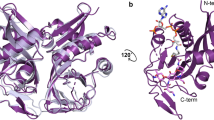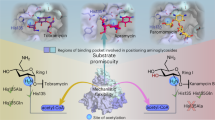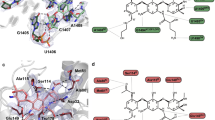Abstract
Antimicrobial-modifying resistance enzymes have traditionally been class specific, having coevolved with the antibiotics they inactivate. Fluoroquinolones, antimicrobial agents used extensively in medicine and agriculture, are synthetic and have been considered safe from naturally occurring antimicrobial-modifying enzymes. We describe reduced susceptibility to ciprofloxacin in clinical bacterial isolates conferred by a variant of the gene encoding aminoglycoside acetyltransferase AAC(6′)-Ib. This enzyme reduces the activity of ciprofloxacin by N-acetylation at the amino nitrogen on its piperazinyl substituent. Although approximately 30 variants of this gene have been reported since 1986, the two base-pair changes responsible for the ciprofloxacin modification phenotype are unique to this variant, first reported in 2003 and now widely disseminated. An intense increase in the medical use of ciprofloxacin seems to have been accompanied by a notable development: a single-function resistance enzyme has crossed class boundaries, and is now capable of enzymatically undermining two unrelated antimicrobial agents, one of them fully synthetic.
This is a preview of subscription content, access via your institution
Access options
Subscribe to this journal
Receive 12 print issues and online access
$209.00 per year
only $17.42 per issue
Buy this article
- Purchase on Springer Link
- Instant access to full article PDF
Prices may be subject to local taxes which are calculated during checkout



Similar content being viewed by others
References
Nikaido, H. Prevention of drug access to bacterial targets: permeability barriers and active efflux. Science 264, 382–388 (1994).
Pechère, J.C. Macrolide resistance mechanisms in gram-positive cocci. Int. J. Antimicrob. Agents 18 Suppl. 1, S25–S28 (2001).
Wang, F., Zhu, D., Hu, F. & Zhang, Y. Surveillance of bacterial resistance among isolates in Shanghai in 1999. J. Infect. Chemother. 7, 117–120 (2001).
Wetzstein, H.G., Schmeer, N. & Karl, W. Degradation of the fluoroquinolone enrofloxacin by the brown rot fungus Gloeophyllum striatum: identification of metabolites. Appl. Environ. Microbiol. 63, 4272–4281 (1997).
Wang, M. et al. Plasmid-mediated quinolone resistance in clinical isolates of Escherichia coli from Shanghai, China. Antimicrob. Agents Chemother. 47, 2242–2248 (2003).
Wang, M., Sahm, D.F., Jacoby, G.A. & Hooper, D.C. Emerging plasmid-mediated quinolone resistance associated with the qnr gene in Klebsiella pneumoniae clinical isolates in the United States. Antimicrob. Agents Chemother. 48, 1295–1299 (2004).
Robicsek, A., Sahm, D.F., Strahilevitz, J., Jacoby, G.A. & Hooper, D.C. Broader distribution of plasmid-mediated quinolone resistance in the United States. Antimicrob. Agents Chemother. 49, 3001–3003 (2005).
Tolmasky, M.E., Roberts, M., Woloj, M. & Crosa, J.H. Molecular cloning of amikacin resistance determinants from a Klebsiella pneumoniae plasmid. Antimicrob. Agents Chemother. 30, 315–320 (1986).
Domagala, J.M. Structure-activity and structure-side-effect relationships for the quinolone antibacterials. J. Antimicrob. Chemother. 33, 685–706 (1994).
Heisig, P. & Tschorny, R. Characterization of fluoroquinolone-resistant mutants of Escherichia coli selected in vitro. Antimicrob. Agents Chemother. 38, 1284–1291 (1994).
Neuhauser, M.M. et al. Antibiotic resistance among gram-negative bacilli in US intensive care units - Implications for fluoroquinolone use. J. Am. Med. Assoc. 289, 885–888 (2003).
Martinez-Freijo, P. et al. Class I integrons in gram-negative isolates from different European hospitals and association with decreased susceptibility to multiple antibiotic compounds. J. Antimicrob. Chemother. 42, 689–696 (1998).
Boyd, D.A. et al. Complete nucleotide sequence of a 92-kilobase plasmid harboring the CTX-M-15 extended-spectrum beta-lactamase involved in an outbreak in long-term-care facilities in Toronto, Canada. Antimicrob. Agents Chemother. 48, 3758–3764 (2004).
Vetting, M.W., Magnet, S., Nieves, E., Roderick, S.L. & Blanchard, J.S. A bacterial acetyltransferase capable of regioselective N-acetylation of antibiotics and histones. Chem. Biol. 11, 565–573 (2004).
Bennett, A.D. & Shaw, W.V. Resistance to fusidic acid in Escherichia coli mediated by the type I variant of chloramphenicol acetyltransferase. Biochem. J. 215, 29–38 (1983).
Murray, I.A. et al. Steroid recognition by chloramphenicol acetyltransferase: engineering and structural analysis of a high affinity fusidic acid binding site. J. Mol. Biol. 254, 993–1005 (1995).
Davies, J.E. Aminoglycoside-aminocyclitol antibiotics and their modifying enzymes. in Antibiotics in Laboratory Medicine (ed. Lorian, V.), 790–809 (Williams & Wilkins, Baltimore, 1986).
Acknowledgements
The authors thank Y. Onodera for suggestions, A. Maden for conducting the liquid chromatography–mass spectroscopy experiments and D. Mills and V. Walker for technical assistance. This study was supported in part by grants AI57576 (to D.C.H.) and AI43312 (to G.A.J.) from the National Institutes of Health, US Public Health Service.
Author information
Authors and Affiliations
Corresponding author
Ethics declarations
Competing interests
Mark Macielag, Darren Abbanat and Karen Bush are employees of Johnson & Johnson Pharmaceutical Research and Development. George A. Jacoby is supported by a research grant from Merck & Co. David C. Hooper is supported by research grants from Daiichi Pharmaceuticals.
Supplementary information
Supplementary Fig. 1
Integron sequence of plasmid pHSH10-2. (PDF 138 kb)
Supplementary Fig. 2
RP-HPLC elution profiles. (PDF 164 kb)
Supplementary Table 1
Clone designations for the site-directed mutagenesis study. (PDF 16 kb)
Supplementary Table 2
Primers used in the site-directed mutagenesis study. (PDF 15 kb)
Rights and permissions
About this article
Cite this article
Robicsek, A., Strahilevitz, J., Jacoby, G. et al. Fluoroquinolone-modifying enzyme: a new adaptation of a common aminoglycoside acetyltransferase. Nat Med 12, 83–88 (2006). https://doi.org/10.1038/nm1347
Received:
Accepted:
Published:
Issue Date:
DOI: https://doi.org/10.1038/nm1347
This article is cited by
-
Multi-drug-resistant Escherichia coli in adult male patients with enlarged prostate attending general hospitals in Benue state
Brazilian Journal of Microbiology (2024)
-
Plasmid-mediated quinolone resistance genes detected in Ciprofloxacin non-susceptible Escherichia coli and Klebsiella isolated from children under five years at hospital discharge, Kenya
BMC Microbiology (2023)
-
It is the time for quorum sensing inhibition as alternative strategy of antimicrobial therapy
Cell Communication and Signaling (2023)
-
Prostatitis: A Review
Current Urology Reports (2023)
-
How Streptococcus suis escapes antibiotic treatments
Veterinary Research (2022)



